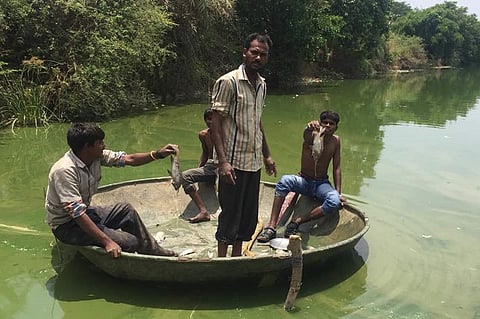

After untreated sewage coupled with a thunderstorm lead to the death of hundreds of fish in Bengaluru’s Doddakallasandra lake, civic agencies are arguing over who should take responsibility for stopping the flow of sewage into the lake.
On Monday, the stench of dead fish enveloped the area of Konankunte surrounding the lake for over 24 hours before authorities acted an entire day later.
Residents of the area say that the lake is divided by a sandbank, with one side filled with untreated sewage water and construction waste, while the other part of the lake remains relatively clean. The residents allege that a thunderstorm on Monday caused the sewage to overflow into the clean side of the lake.
But state authorities are refuting this claim. According to Chief Executive Officer of the Karnataka State Lake Development Authority, Vidhyasagar Rao, the fish were killed because untreated sewage was flowing into the storm water drains and eventually polluting the entire lake, not just one part of it.
“This waste comes from the residential area surrounding the lake. As there was already high sewage content in the lake, the thunderstorm on Monday resulted in the oxygen levels in the lake to drop drastically, which led to the fish deaths. Fish deaths occur only during the April and May showers in lakes which are heavily polluted with effluents and sewage,” Rao said.
Priyanka Jamewala, Research Fellow at Ashoka Trust for Research in Ecology and the Environment, explained, "In summers, due to the increase in temperature, the dissolved oxygen in the water is low. The untreated sewage aggravates the problem by increasing the ammonia content in the water and reducing the dissolved oxygen content further, which results in fish death."
When The News Minute contacted civic agencies, Bengaluru Water Supply and Sewerage Board and Bruhat Bengaluru Mahanagara Palike, to question why the sewage inflow into the storm water drains was not plugged, the agencies began their usual jurisdictional blame game.
BWSSB Chief Engineer Kemparamaiah said that the residential area surrounding the lake is not under their jurisdiction.
“This area falls under the Bruhat Bengaluru Mahanagara Palike as it is part of the 110 villages that were added to the BBMP jurisdiction in 2005. BWSSB does not have these areas under its jurisdiction and hence we are not responsible for plugging the sewage pipes that are allowing the waste to flow into the rajakaluves (storm water drains),” Kemparamaiah said.
Assistant executive engineer of BWSSB, Gangadhar said that the BBMP has not yet handed over the responsibility of maintaining the sewage system to the BWSSB even after 11 years.
"Only recently, they handed over the water supply responsibilities to us and that was also 11 years after the BBMP took over the 110 villages into its jurisdiction. These areas still don't have Cauvery water supply and tenders were called only in April for the construction of the water pipelines. No tenders have been called for constructing a sewage system and the residents have to take care of the laying of sewage pipes from their homes themselves. The sewage system in that area is not at all planned and almost all sewage pipes are connected to storm water drains. Hence untreated water is flowing into the lakes," Gangadhar added.
A senior official with the BBMP countered the BWSSB’s claims and said that plugging sewage pipes falls under the water supply agency’s jurisdiction.
“We have taken measures to clean up the lake, but plugging sewage pipes must be done by the BWSSB,” a senior BBMP official said.
The KSLDA has directed the Karnataka State Pollution Control Board to probe the allegation by the residents that a construction site being developed by the Prestige Group was diverting construction waste and effluents into the lake.